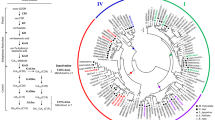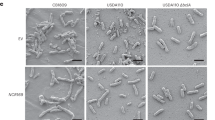Abstract
The MtTrHb1 and MtTrHb2 genes of the model legume Medicago truncatula Gaertn. encode proteins homologous to truncated hemoglobins (TrHb) from plants and a range of different microorganisms. Induction of MtTrHb1 in root nodules and expression of MtTrHb2 in root nodules, as well as in mycorrhizal roots, were shown by quantitative real-time reverse transcription–polymerase chain reaction (RT–PCR). The promoters of both genes were PCR-amplified and fused to the gusAint coding region. By analysing these gusAint-fusions in transgenic root tissues, we were able to localize their activity in root nodules and in roots colonized by arbuscular mycorrhizal (AM) fungi. Whereas the promoter of MtTrHb1 was activated in the infected cells of the nitrogen-fixing zone of root nodules, the MtTrHb2 promoter was predominantly active in the nodule vascular tissue. This expression pattern correlates with the presence of an ‘organ-specific element’ (OSE)-like sequence in the MtTrHb1 promoter, which is not present in the MtTrHb2 regulatory unit. Concerning the AM symbiosis, only the MtTrHb2 promoter mediated an expression in arbuscule-containing cells and in the root vascular tissue of mycorrhizal root segments colonized by the fungus Glomus intraradices.




Similar content being viewed by others
Abbreviations
- AM :
-
Arbuscular mycorrhizal
- BAC :
-
Bacterial artificial chromosome
- dpi :
-
Days post inoculation
- EST :
-
Expressed sequence tag
- Hb :
-
Hemoglobin
- Lb :
-
Leghemoglobin
- NO :
-
Nitric oxide
- OSE :
-
Organ-specific element
- TC :
-
Tentative consensus sequence
- TrHb :
-
Truncated hemoglobin
References
Appleby CA (1984) Leghemoglobin and Rhizobium respiration. Annu Rev Plant Physiol 35:443–476
Arnon DI, Hoagland DR (1940) Crop production in artificial culture solutions and in soils with special reference to factors influencing yields and absorption of inorganic nutrients. Soil Sci 50:463–483
Bonanomi A, Wiemken A, Boller T, Salzer P (2001) Local induction of a mycorrhiza-specific class III chitinase gene in cortical root cells of Medicago truncatula containing developing or mature arbuscules. Plant Biol 3:194–199
Bustin SA (2000) Absolute quantification of mRNA using real-time reverse transcription polymerase chain reaction assays. J Mol Endocrinol 25:169–193
Casse F, Boucher D, Julliot JS, Michel M, Denarie J (1979) Identification and characterization of large plasmids in Rhizobium meliloti using agarose gel electrophoresis. J Gen Microbiol 113:229–242
Cueto M, Hernandez-Perera O, Martin R, Bentura ML, Rodrigo J, Lamas S, Golvano MP (1996) Presence of nitric oxide synthase activity in roots and nodules of Lupinus albus. FEBS Lett 398:159–164
Cullimore J, Denarie J (2003) Plant sciences. How legumes select their sweet talking symbionts. Science 302:630-633
Delledonne M, Xia YJ, Dixon RA, Lamb C (1998) Nitric oxide functions as a signal in plant disease resistance. Nature 394:585–588
Dordas C, Hasinoff BB, Igamberdiev AU, Manac’h N, Rivoal J, Hill RD (2003) Expression of a stress-induced hemoglobin affects NO levels produced by alfalfa root cultures under hypoxic stress. Plant J 35:763–770
Duc G, Trouvelot A, Gianinazzi-Pearson V, Gianinazzi S (1989) First report of non-mycorrhizal plant mutants (myc−) obtained in pea (Pisum sativum L.) and fababean (Vicia faba L.). Plant Sci 60:215–222
Durner J, Wendehenne D, Klessig DF (1998) Defense gene induction in tobacco by nitric oxide, cyclic GMP, and cyclic ADP-ribose. Proc Natl Acad Sci USA 95:10328–10333
Fedorova M, van de Mortel J, Matsumoto PA, Cho J, Town CD, VandenBosch KA, Gantt JS, Vance CP (2002) Genome-wide identification of nodule-specific transcripts in the model legume Medicago truncatula. Plant Physiol 130:519–537
Flogel U, Merx MW, Godecke A, Decking UKM, Schrader J (2001) Myoglobin: a scavenger of bioactive NO. Proc Natl Acad Sci USA 98:735–740
Franche C, Diouf D, Laplaze L, Auguy F, Frutz T, Rio M, Duhoux E, Bogusz D (1998) Soybean (lbc3), Parasponia, and Trema hemoglobin gene promoters retain symbiotic and nonsymbiotic specificity in transgenic Casuarinaceae: implications for hemoglobin gene evolution and root nodule symbioses. Mol Plant Microbe Interact 11:887–894
Frühling M, Roussel H, Gianinazzi-Pearson V, Pühler A, Perlick AM (1997) The Vicia faba leghemoglobin gene VfLb29 is induced in root nodules and in roots colonized by the arbuscular mycorrhizal fungus Glomus fasciculatum. Mol Plant Microbe Interact 10:124–131
Gianinazzi-Pearson V (1997) Have common plant systems co-evolved in fungal and bacterial root symbioses? In: Legocki A, Bothe H, Pühler A (eds) Biological fixation of nitrogen for ecology and sustainable agriculture: NATO ASI Series, vol G39. Springer, Berlin Heidelberg New York, pp 321–324
Hänsch R, Koprek T, Mendel RR, Schulze J (1995) An improved protocol for eliminating endogenous beta-glucuronidase background in barley. Plant Sci 105:63–69
Harrison MJ (1999) Molecular and cellular aspects of the arbuscular mycorrhizal symbiosis. Annu Rev Plant Physiol Plant Mol Biol 50:361–389
Harrison MJ, Dewbre GR, Liu J (2002) A phosphate transporter from Medicago truncatula involved in the acquisition of phosphate released by arbuscular mycorrhizal fungi. Plant Cell 14:2413–2429
Herouart D, Baudouin E, Frendo P, Harrison J, Santos R, Jamet A, Van de Sype G, Touati D, Puppo A (2002) Reactive oxygen species, nitric oxide and glutathione: a key role in the establishment of the legume–Rhizobium symbiosis? Plant Physiol Biochem 40:619–624
Hohnjec N, Perlick AM, Puhler A, Kuster H (2003) The Medicago truncatula sucrose synthase gene MtSucS1 is activated both in the infected region of root nodules and in the cortex of roots colonized by arbuscular mycorrhizal fungi. Mol Plant Microbe Interact 16:903–915
Jefferson RA, Kavanagh TA, Bevan MV (1987) GUS fusions: β-glucuronidase as a sensitive and versatile gene fusion marker in higher plants. EMBO J 6:3901–3907
Journet EP, El-Gachtouli N, Vernoud V, de Billy F, Pichon M, Dedieu A, Arnould C, Morandi D, Barker DG, Gianinazzi-Pearson V (2001) Medicago truncatula ENOD11: A novel RPRP-encoding early nodulin gene expressed during mycorrhization in arbuscule-containing cells. Mol Plant Microbe Interact 14:737–748
Kundu S, Trent JT, Hargrove M (2003) Plants, humans and hemoglobins. Trends Plant Sci 8:387–393
Küster H, Quandt HJ, Broer I, Perlick AM, Pühler A (1995) The promoter of the Vicia faba L. VfENOD-GRP3 gene encoding a glycine-rich early nodulin mediates a predominant gene expression in the interzone II–III region of transgenic Vicia hirsuta root nodules. Plant Mol Biol 29:759–772
Lamattina L, Garcia-Mata C, Graziano M, Pagnussat G (2003) Nitric oxide: the versatility of an extensive signal molecule. Annu Rev Plant Biol 54:109–136
Limpens E, Ramos J, Franken C, Raz V, Compaan B, Franssen H, Bisseling T, Geurts R (2004) RNA interference in Agrobacterium rhizogenes-transformed roots of Arabidopsis and Medicago truncatula. J Exp Bot 55:983–992
Lum MR, Hirsch AM (2002) Roots and their symbiotic microbes: strategies to obtain nitrogen and phosphorus in a nutrient-limiting environment. J Plant Growth Regul 21:368–382
Mathesius U (2003) Conservation and divergence of signalling pathways between roots and soil microbes—the Rhizobium–legume symbiosis compared to the development of lateral roots, mycorrhizal interactions and nematode-induced galls. Plant Soil 255:105–119
Mathieu C, Moreau S, Frendo P, Puppo A, Davies MJ (1998) Direct detection of radicals in intact soybean nodules: presence of nitric oxide–leghemoglobin complexes. Free Rad Biol Med 24:1242–1249
Ouellet H, Ouellet Y, Richard C, Labarre M, Wittenberg B, Wittenberg J, Guertin M (2002) Truncated hemoglobin HbN protects Mycobacterium bovis from nitric oxide. Proc Natl Acad Sci USA 99:5902–5907
Pawlowski K, Bisseling T (1996) Rhizobial and actinorrhizal symbioses: what are the shared features? Plant Cell 8:1899-1913
Provorov NA, Borisov AY, Tikhonovich IA (2002) Developmental genetics and evolution of symbiotic structures in nitrogen-fixing nodules and arbuscular mycorrhiza. J Theor Biol 214:215–232
Quandt HJ, Pühler A, Broer I (1993) Transgenic root nodules of Vicia hirsuta: a fast and efficient system for the study of gene expression in indeterminate-type nodules. Mol Plant Microbe Interact 6:699–706
Salzer P, Corbiere H, Boller T (1999) Hydrogen peroxide accumulation in Medicago truncatula roots colonized by the arbuscular mycorrhiza-forming fungus Glomus intraradices. Planta 208:319–325
Schüssler A, Schwarzott D, Walker C (2001) A new fungal phylum, the Glomeromycota: phylogeny and evolution. Mycol Res 105:1413–1421
Seregelyes C, Mustardy L, Ayaydin F, Sass L, Kovacs L, Endre G, Lukacs N, Kovacs I, Vass I, Kiss GB, Horvath GV, Dudits D (2000) Nuclear localization of a hypoxia-inducible novel non-symbiotic hemoglobin in cultured alfalfa cells. FEBS Lett 485:127
Seregelyes C, Barna B, Hennig J, Konopka D, Pasternak TP, Lukacs N, Feher A, Horvath GV, Dudits D (2003) Phytoglobins can interfere with nitric oxide functions during plant growth and pathogenic responses: a transgenic approach. Plant Science 165:541–550
Smith SE, Read DJ (1997) Mycorrhizal symbiosis. Academic Press, London
Stougaard J, Sandal N, Gron A, Kuhle A, Marcker K (1987) 5′ analysis of the soybean leghaemoglobin lbc3 gene: regulatory elements required for promoter activity and organ specificity. EMBO J 6:3565–3569
Thorsteinsson MV, Bevan DR, Potts M, Dou Y, Eich RF, Hargrove MS, Gibson QH, Olson JS (1999) A cyanobacterial hemoglobin with unusual ligand binding kinetics and stability properties. Biochemistry 38:2117–2126
Trinchant JG, Rigaud J (1982) Nitrite and nitric oxide as inhibitors of nitrogenase from soybean bacteroid. Appl Environ Microbiol 44:1385–1388
Vierheilig H, Coughlan AP, Wyss U, Piche Y (1998) Ink and vinegar, a simple staining technique for arbuscular-mycorrhizal fungi. Appl Environ Microbiol 64:5004–5007
Vieweg MF, Frühling M, Quandt HJ, Heim U, Bäumlein H, Pühler A, Küster H, Perlick AM (2004) The promoter of the Vicia faba L. leghemoglobin gene VfLb29 is specifically activated in the infected cells of root nodules and in the arbuscule-containing cells of mycorrhizal roots from different legume and non-legume plants. Mol Plant Microbe Interact 17:62–69
Watts RA, Hunt PW, Hvitved AN, Hargrove MS, Peacock WJ, Dennis ES (2001) A hemoglobin from plants homologous to truncated hemoglobins of microorganisms. Proc Natl Acad Sci USA 98:10119–10124
Wittenberg JB, Bolognesi M, Wittenberg BA, Guertin M (2002) Truncated hemoglobins: a new family of hemoglobins widely distributed in bacteria, unicellular eukaryotes, and plants. J Biol Chem 277:871–874
Wulf A, Manthey K, Doll J, Perlick AM, Linke B, Bekel T, Meyer F, Franken P, Kuster H, Krajinski F (2003) Transcriptional changes in response to arbuscular mycorrhiza development in the model plant Medicago truncatula. Mol Plant Microbe Interact 16:306–314
Acknowledgements
We thank the Deutsche Forschungsgemeinschaft for supporting this work in the frame of the SPP1084 (MolMyk) project Pe814/1-2 and Prof. Alfred Pühler for critical reading of the manuscript.
Author information
Authors and Affiliations
Corresponding author
Rights and permissions
About this article
Cite this article
Vieweg, M.F., Hohnjec, N. & Küster, H. Two genes encoding different truncated hemoglobins are regulated during root nodule and arbuscular mycorrhiza symbioses of Medicago truncatula. Planta 220, 757–766 (2005). https://doi.org/10.1007/s00425-004-1397-0
Received:
Accepted:
Published:
Issue Date:
DOI: https://doi.org/10.1007/s00425-004-1397-0




